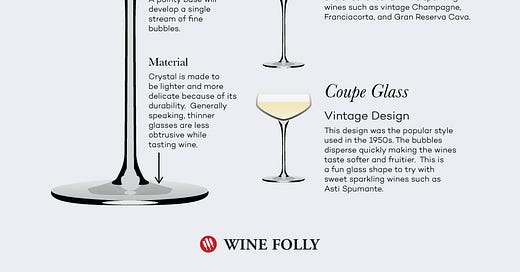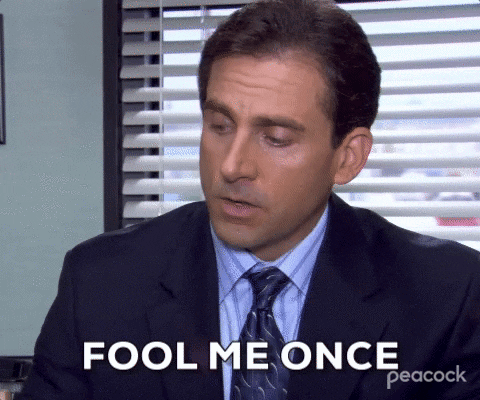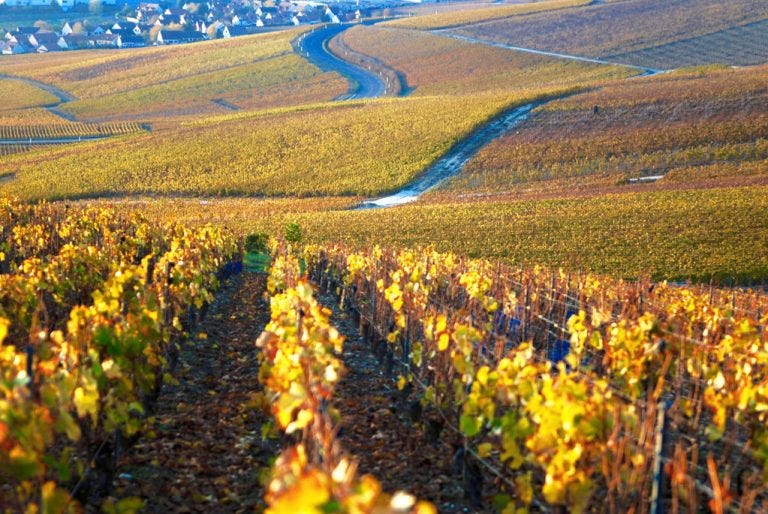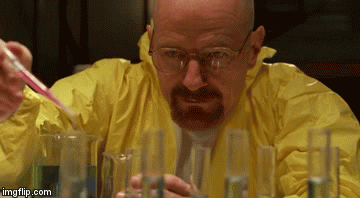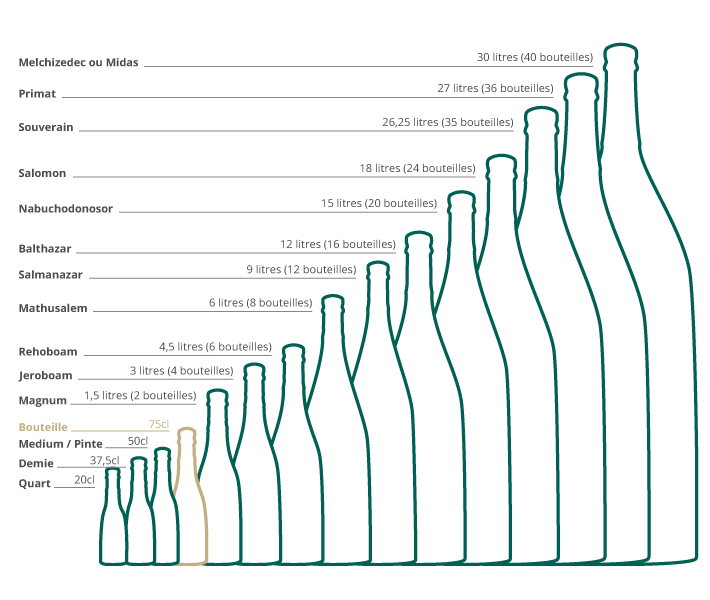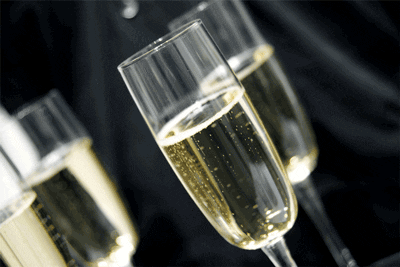#10 - Champagne, New Year, video tour, and cheers
Welcome back to the hottest newsletter this side of the Mississippi!
Upon us, the last days of the year. And what a year it has been. Here is to the new year! I believe it is time to uncork the bottle we pair with the finalizing of 2020 in Stovetop Hot, take a video tour of a French town in Sunday Dinner, and of course save room for some bubbly recs in Microwaving those leftovers.
Stovetop Hot: Fizz the season!
Me: Why hello there Champagne. How are you my man?
Champ’: Bubblin. Ready to ring in New Year’s Eve?
Me: Yes, let’s just make sure not to make pour decisions.
Champ’: Well, sometimes you just gotta pop off!
Living in a different country other than your homeland, you learn things. Champagne ([shan pah gn] in french) is one of those things that I have increased in my knowledge while living abroad. Not necessarily from drinking a lot of it! It is part of the culture here in Paris, along with those other famous wines that are produced in the south-west as well. Yet, if there is a time of the year to celebrate with a glass, it is now.
Champagne comes from the north-eastern region in France, rightfully called Champagne. If you ever get a bottle back in the States, or anywhere in the world actually, it has to come from this specific region to be labeled as such. Hence, mentions like “Product of Russia” or any derivative of the name into “champaign” or “champaña” should prevent you from buying it if you want to drink the real thing. Since 2006, there has been a special authorization in the States for American winemakers, allowing them to write on their products ‘California champagne’ or ‘Oregon champagne’. It only goes for the US market though, and if these bottles were to be commercialized in Europe, they would be considered counterfeits. One last trick to make sure you bought real Champagne is to check the label, the cork and every element of the packaging, as well as the crate: there should be a mention of the word Champagne on each and every part of the product. Finally, when buying your bottle, remember: a surprisingly low price is never a good sign.
A few years ago, a company tried to “mis-label” their product. Yet, the standards fixed by the Comité Interprofessionnel du vin de Champagne were not met, aka there was no proper lot number to be found on the packages… No less than 9,200 bottles and 40,000 fake labels were disposed of by the Italian police. I will let you do the math in your head for that loss.
History time, broken bottles and happy accidents
The history of how this region became famous for this particular sparkling wine has much to do with trying to rival other wine regions from the South of France until they found their way. Cultivation of grapes took time not only for the farmers but also because of the political agendas throughout the generations of winemakers and their rivalries.
The Church became involved and would later own vineyards. Fast forward some centuries, and this is the region where the Kings of France were anointed.
The climate being away from the sea, it was extremely difficult to grow grapes that were intended for red wine making here. There would be different levels of acidity, sugar, and a lot of the times the grapes would not be able to fully ripen. The grapes of Pinot noir, Pinot meunier, and Chardonnay are primarily used at more than 100 Champagne houses throughout the region.
In the beginning though, there were accidents, many accidents in making this wine. There was too much pressure in the bottles: the system of using a muselet to prevent the corks from blowing out wasn’t ready at the time. With the exploding bottles, this sparkling wine was actually labeled le vin du diable… devil’s wine. There could be as much as 90 percent of the bottles you produced for the market that had been touched by the devil overnight and burst as you arrived the following day. That trusty little muselet mentioned above is the wire that you untwist before slowly twisting the cork to open the sparkling wine bottle. Of course it has gone through a few upgrades through the years to what we have now. Whelsh!
Now, let’s introduce a little science, aka fermentation.
Going by to my science class in middle school, this is the metabolic process that produces chemical changes in organic substances through the action of enzymes. Originally, Champagne was produced using what was called the méthode rurale. The initial fermentation had not finished before the bottle was corked: the real reason why all of those bottles exploded long ago or the corks popped out of them. It wasn’t until English scientist and physician Christopher Merret created the méthode champenoise that the entire fabrication changed. This revelation, made in the 17th century, wasn’t adapted until the 19th century. Now count up millions of bottles this time, for your loss counter in terms of money over this time. Merret’s method introduced a second fermentation to the process before corking the bottles by adding yeast and rock sugar. With the strict regulations concerning the sparkling wine, there also has to be a minimum of 1.5 years to develop the flavors according to the appellation d'origine contrôlée. Just a little note for you, try to find a bottle of millésime, it has matured for at least 3 years - the harvest comes from fully ripened grapes that aren’t mixed with other varieties, and will produce a more intense flavor. It is outstanding.
A word that you will encounter in the show Emily in Paris (S1 E8) is remuage. After the aging of Champagne, this is the process of turning the bottles so that the dead yeast, lees, can settle in the neck of the bottle. The “neck” is then frozen and the cap of the bottle is removed. The pressure in the bottle actually forces out the ice containing the lees. This is where some additional sugar might be added to not only maintain the level within the bottle but also to adjust the sweetness. Depending on its sugar concentration, the champagne will become raw/brut (between 6 and 20 grams of sugar per liter), dry/sec (between 17 and 35 g/l), semi-dry/demi-sec (between 33 and 50 g/l) or sweet/doux (over 50 g/l). An extra brut Champagne will be obtained by adding the same wine from another bottle, and will therefore be without added sugar. With that knowledge, it is usual to go for a brut or sec for a toast at the beginning of a meal, and a demi-sec or doux for dessert.
In terms of bottles, be my guest and pick from the multitudes of quantities you can find, and their cool names :
The 3 most sold ones are the regular bouteille, also called Champenoise, the Magnum, and the Jeroboam.

If you thought science class was over… well it is, but we can still use fancy words. Welcome in Nucleation 101, aka the process of forming bubbles.
The way that Champagne gets this delectable effervescence is from the carbon dioxide in the bottle but also because of the Champagne flute. To each type, its own :
Finally, the rise of popularity to this sparkling wine has many combination factors: to mark contemporary political events, the national pride, and the association to sporting events. The Formula 1 Grand Prix circuit may have considerably helped with this, with the now-famous “spraying” of the champagne after winning a race. If you ever have seen a championship series for a multitude of sports, at the end, there is always champagne involved.
Former British Prime Minister Tony Blair held a Champagne reception to celebrate London winning the right to host the 2012 Olympic games. Lastly, don’t forget the bottles used to smash over the hull of a ship’s inaugural launch. Leisure and celebration, both in their own rights. With this little bit of History, enjoy your time drinking on the bubbly and stay away from trying to open it with a knife, a sword or a lighter. That video will probably end up on the internet as a “what not to do'' when opening a Champagne bottle.
Sunday Dinner: Walking in Reims, Champagne.
This week, after dinner, we decided to enjoy a few Christmas decorations from a walk in Reims, before curfew. Follow us in our walk, taking it one step at a time, to enjoy the end of this festive month.
Microwaving those leftovers: Looking backwards and forwards in the last best recs of 2020.
Good news! With a dominant news cycle on Covid-19, you probably didn’t hear much on polio and how in Africa, it was finally eradicated. Dr. Tedros Adhanom Ghebreyesus declared this “as one of the greatest public health achievements of our time.” Cheers!
There will be numerous “virtual concerts” this year for NYE. If you like Justin Bieber, to which everyone has at least one song in their library, he is offering a free concert for those with a T-mobile account. Otherwise, you need to pay 25 dollars. It could be fun! Click here to find out more about JB.
Still on the music kick here, one of my favorite artists, Kid Cudi, just came out with his new album, Man on the Moon III. His music is intellectual rap in my opinion, I have liked this artist since 2009. Give it a listen on spotify or youtube - yes it does have a few curse words. Sorry mom.
For a cool account to follow on Instagram, check out reimstourisme first. It is the city that I visited over the Christmas holidays, in the center of the Champagne region. Enjoy all of the cool pics they have.
What are your plans for this year? Do you have anything fun planned? Do you have a little tradition to ring in the new year? For me, this is the time to reflect a little. I raise my glass to cheers to you and yours for health and wealth in this new year. Don’t forget to eat your greens and black-eyed peas for that little bit of luck. I could not have been more pleased with the response that we have received for the newsletter from you, the readers. Thank you so much and Happy New Year!
Thank you for your time in reading this week’s newsletter, and thank you to the best team in the business for making it possible. Try out one of the recipes from the previous editions and don't hesitate to share with me the pictures of what you've been cooking by tagging me on Instagram @cookingwithburtonwebb.
Au revoir,
Burton
